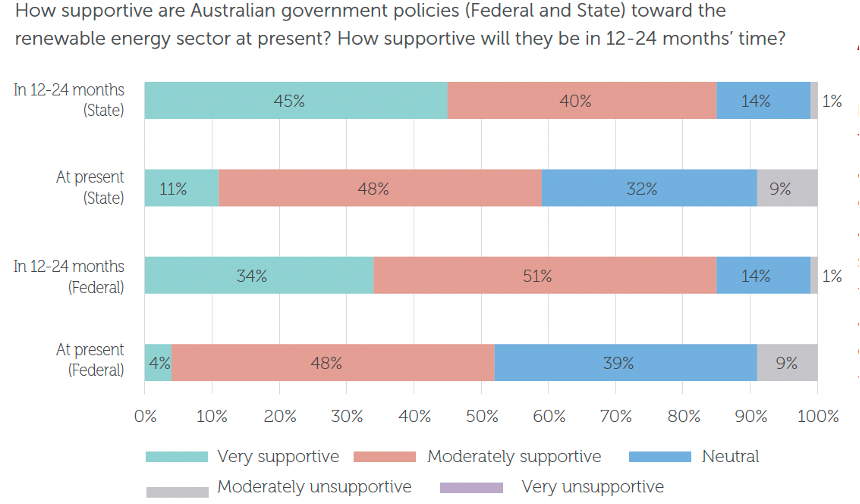-
International and domestic investors plan to increase their Australian renewable energy investment this year and beyond.
And the role of Government policy settings seems key to this boost in confidence, the MinterEllison and Mergermarket Australian Renewables Report 2023 report finds.
"The Australian government’s goal to generate 50 per cent of electricity from renewable sources by 2030 provides a stable and supportive regulatory environment.”
Strategic investors, environmental, social and governance (ESG) focused funds, original equipment manufacturers (OEMs) and traditional energy providers looking for transitional assets are some of the parties interested in Australia’s renewable energy sector.
According to the report almost three-quarters of global and domestic investors will increase investments in Australian renewables through 2023. This is a noticeable uptick from 2021, when it was 65 per cent, and 2019 when it was 68 per cent.
The research also finds 91 per cent of investors expect investment from Asia Pacific to increase in the next one to two years with Japan the most active investor. About 83 per cent nominated increased investment from Europe, while 57 per cent tipped increased investment from North America.
Due to this increased interest, there is a high level of competition for operational assets and assets under development - particularly those which are ready to build and at an advanced stage of grid connection.
{CF_IMAGE}
The Australian government’s goal to generate 50 per cent of electricity from renewable sources by 2030 provides a stable and supportive regulatory environment.
Investors expect government policies at state and federal levels to become more supportive over the next two years and 85 per cent of investors say federal and state policies will be supportive or very supportive towards renewables in 2023 and beyond.
Very few investors felt Australia’s governments would lack support in the near future and 72 per cent say government renewable and emissions reduction targets are a key strength.
New South Wales’s clear road map and high levels of energy demand, along with the support of renewable energy zones (REZ) has made it the most attractive investment location for future investments for 60 per cent of investors.
The renewable energy zones, particularly the Central-West Orana REZ and New England REZ, will provide the backbone for massive forward investment in generation, firming and storage and provide a clear investment signal. After NSW, Victoria is considered the next most attractive location.
Mergers and acquisitions (M&A) will continue to be a key driver of future trends with half the investors pointing to growth through acquisition, along with 52 per cent saying a bolt-on acquisition was among the main objectives of their most recent deal.
Oil and gas investors who want to decarbonise their activities are active and more than 10 per cent of renewables deals by volume in 2022 had oil company backing.
The M&A landscape for Australian renewables is strong, buoyed by the announcement of renewable energy targets, the scheduled shutdown of coal-fired generators and a supportive Federal Government policy environment.
{CF_IMAGE}
Solar jump
Recent renewable energy investments in Australia yielded the intended value from the deal or met the business objectives of 65 per cent investors.
And while 97 per cent of investors see Photovoltaic solar and hybrid batteries presenting the most investor opportunities, the biggest jump in investor sentiment over 2022 was in Biomass/Biogas/Waste-2 energy where 83 per cent of investors opportunities, up from 59 per cent in 2021.
At the same time 40 per cent expect hydrogen to catch up with expectations and/or reach maturity within one to two years. Notably, one in every six deals in 2022 in the Australian renewables M&A market involved assets linked to hydrogen production.
Challenges ahead
{CF_IMAGE}
Over inflated valuations has replaced regulation and incentives concerns as the top challenge facing renewables investors. There was a notable jump in respondents who think valuations are too high with 73 per cent now citing this as a concern, compared with 55 per cent from two years ago.
Investors must also factor in the long-run implications of inflation – now at a near 40-year high in Australia. So investment and financing challenges remain.
More than half of respondents (53 per cent) hold this view and most respondents (91 per cent) agree new financing and refinancing for renewables projects will become more difficult in the year ahead.
But, as our study shows, investors are facing up to the headwinds and are ready to seize the opportunities that lie ahead.
Andrea Frank and Simon Harvey are partners at MinterEllison
Methodology
In Q1 2023, MinterEllison and Mergermarket canvassed the opinions of 100 renewable energy investors to gauge their views on the investment opportunities, trends and challenges in Australia. 60 per cent were based outside Australia while 40 per cent were Australian firms. All respondents had in the past 12-24 months developed/ funded/ invested in at least one Australian-based renewable energy project. Within the graphed survey results, percentages may not sum to 100 per cent due to rounding, or when respondents were allowed to choose more than one answer.
The views and opinions expressed in this communication are those of the author and may not necessarily state or reflect those of ANZ.
-
-
-
anzcomau:Bluenotes/social-and-economic-sustainability,anzcomau:Bluenotes/Environment
Investor confidence in Australian renewable energy assets strengthens
2023-08-11
/content/dam/anzcomau/bluenotes/images/articles/2023/August/thomas-richter-B09tL5bSQJk-unsplash.jpg
EDITOR'S PICKS
-
Making better use of the energy we have today is both a reliable way to lower emissions and improve energy affordability.
25 May 2023 -
Economic growth is pointless if biodiversity is bulldozed in the process. There is a growing consensus for change.
24 April 2023



